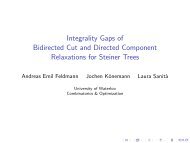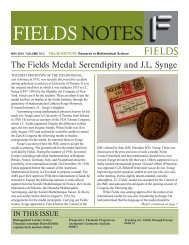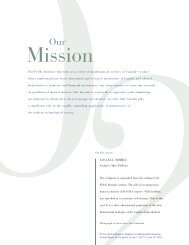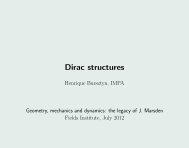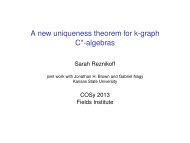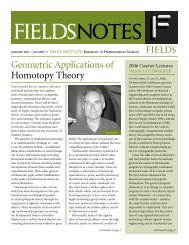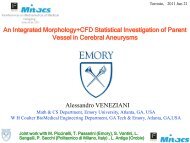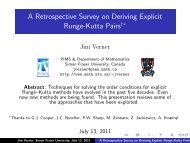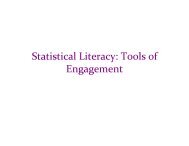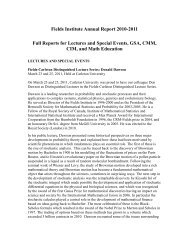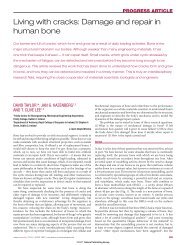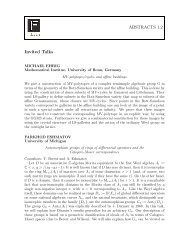Annual Report 2005 - Fields Institute - University of Toronto
Annual Report 2005 - Fields Institute - University of Toronto
Annual Report 2005 - Fields Institute - University of Toronto
Create successful ePaper yourself
Turn your PDF publications into a flip-book with our unique Google optimized e-Paper software.
THE NATIONAL PROGRAM ON COMPLEX<br />
DATA STRUCTURES (NCPDS)<br />
Director: Jamie Stafford (<strong>Toronto</strong>)<br />
Program Committee: David Bellhouse (UWO), Richard<br />
Cook (Waterloo), Paul Gustafson (UBC) Mike Hidiroglou<br />
(Statistics Canada), Nancy Reid (<strong>Toronto</strong>), Randy Sitter<br />
(Simon Fraser), Ed Susko (Dalhousie), and Louis-Paul<br />
Rivest (Laval)<br />
NPCDS is a joint initiative between Canada’s Statistical<br />
Sciences Community and the nation’s three Mathematical<br />
Sciences <strong>Institute</strong>s, with funding provided by NSERC. Its<br />
goal is to foster nationally coordinated interdisciplinary<br />
research projects involving interactions between statisticians<br />
and scientists working with complex data sets. A<br />
two-stage mechanism is used in which an inaugural workshop<br />
gets the research network going, to be following by a<br />
proposal for a two-year research project.<br />
During the 2004–05 year projects and pilot projects<br />
within the National Program met April 9–4 at the Banff<br />
International Research Station. Leaders in Computer<br />
Experiments, Data Mining, Genomics and Survey Methods<br />
each organized a day <strong>of</strong> activity in their respective fields.<br />
An additional day was devoted to three pilot projects that<br />
had inaugural workshops planned in the areas <strong>of</strong> Biomedicine,<br />
Forestry and Marine Ecology. Research presentations<br />
were incredibly varied and included topics that concerned<br />
pharmacophore identification, complex HIV proteomic<br />
data structures, communications security, studies <strong>of</strong> complex<br />
traits, social behaviour, forest fires, high throughput<br />
genomics, tracking <strong>of</strong> leatherback turtles, turbulence, and<br />
so on. Underlying such a diverse set <strong>of</strong> topics was a genuine<br />
common interest in complex data, regardless <strong>of</strong> its origin.<br />
This, in effect, bonded participants in their vision <strong>of</strong> what<br />
NPCDS can bring to the statistical sciences community in<br />
Canada. As such the event was instrumental in generating<br />
considerable enthusiasm for the Program’s model. Concretely,<br />
the establishment <strong>of</strong> interdisciplinary projects with<br />
quantitative leadership was viewed as a vehicle that gives<br />
the statistical community a greater voice in the research<br />
agendas <strong>of</strong> other disciplines. These projects have the potential<br />
to create a culture in statistics where training takes<br />
place in intensely interdisciplinary environments ensuring<br />
young researchers become effective collaborators in the<br />
long run. This was evident by the number <strong>of</strong> excellent presentations<br />
given by graduate students, including Norberto<br />
Pantoja Galicia, Jason Loeppky, Pritam Ranjan and others<br />
T h e N a t i o n a l P r o g r a m o n<br />
C o m p l e x D a t a S t r u c t u r e s<br />
The event was timely as the Program is currently entering<br />
the second half <strong>of</strong> its four year funding cycle and it <strong>of</strong>fered<br />
an opportunity for participants to assess what has been<br />
accomplished thus far. The general view was “a lot!”. With<br />
potentially seven national projects established in a two year<br />
span the Program has engaged the broader community<br />
in a robust way. Credit must be attributed to the many<br />
individual researchers who are investing time and energy in<br />
this endeavour. During the week at Banff general meetings<br />
were held where progress, and the future <strong>of</strong> the program,<br />
was discussed openly. For example, issues concerning<br />
budget surpluses led to consideration <strong>of</strong> an RFP for training<br />
initiatives, which is now being drafted for the approval <strong>of</strong><br />
NPCDS governance. In addition, plans for the renewal <strong>of</strong><br />
the program have been set in motion, although these have<br />
been complicated by the uncertainty surrounding NSERC’s<br />
reallocation process. One positive development has been<br />
the consideration <strong>of</strong> expanding the Program as a joint<br />
CIHR/NSERC initiative. This appears to be an extremely<br />
exciting, if challenging, prospect. General enthusiasm for<br />
this comes not only from our own community, but also<br />
from key players within CIHR. This gives some cause for<br />
cautious optimism.<br />
Enthusiasm for the National Program from other disciplines<br />
was clearly evident during the inaugural workshop<br />
on Forests, Fires and Stochastic Modelling held at the <strong>Fields</strong><br />
<strong>Institute</strong> May 24–28, <strong>2005</strong> (see the detailed report later in<br />
this section). Forest fires are a natural component <strong>of</strong> many<br />
<strong>of</strong> Canada’s forested ecosystems but they also pose threats<br />
to public safety, property and forest resources. Every year,<br />
forest fires cause millions <strong>of</strong> dollars worth <strong>of</strong> damage and<br />
force the evacuation <strong>of</strong> some communities. Such problems<br />
will be exacerbated as people establish more homes and cottages<br />
in and near forested areas and climate change alters<br />
forest vegetation and weather. The purpose <strong>of</strong> the workshop<br />
was to bring together forestry researchers and statisticians<br />
to identify areas <strong>of</strong> potential collaboration. The event began<br />
with a day <strong>of</strong> introduction to the language <strong>of</strong> forest fires<br />
with contributions by researchers from the Ontario Ministry<br />
<strong>of</strong> Natural Resources, the Canadian Forest Service,<br />
Fire Science Lab and the US Forest Service. The remainder<br />
<strong>of</strong> the workshop focused more on statistical techniques,<br />
although even here applications abounded including modeling<br />
wildfires, lightning strikes, seismology, fire indices,<br />
visualization, weevil infestations, Boreal ecosystems and so<br />
on. Many keynote speakers such as David Vere-Jones, David<br />
Brillinger, Gail Ivan<strong>of</strong>f, Andre Dabrowski, Dean Slonowsky,<br />
focused on issues <strong>of</strong> considerable depth including spatial<br />
<strong>Fields</strong> <strong>Institute</strong> <strong>2005</strong> ANNUAL REPORT 47



